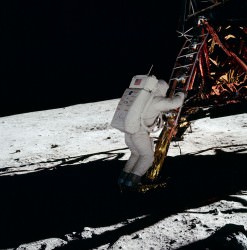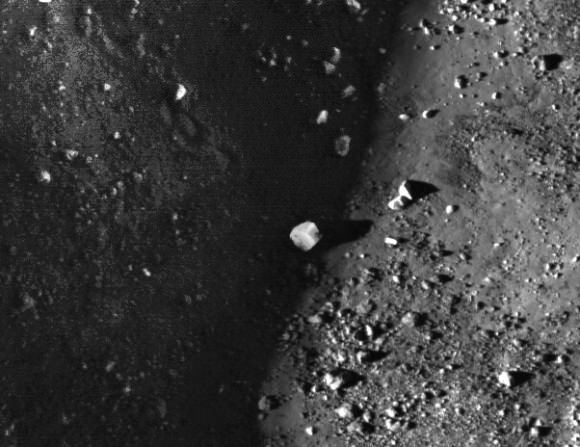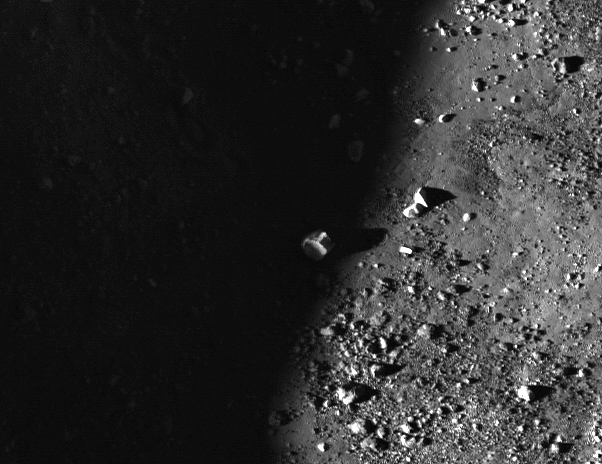[/caption]
A lunar boulder catches the last edge of the setting sunlight in this image from the Lunar Reconnaissance Orbiter Camera. The boulders litter the floor of an unnamed 3.5 km wide (2.17 mile wide) crater located within the much larger crater Lobachevskiy. The smaller crater’s rim casts its shadow along the left side of the image, and raises the question: why are shadows on the Moon so dark?
On Earth, air scatters light and allows objects not in direct sunlight to be still well-lit. This is an effect called Rayleigh scattering, named for the British Nobel-winning physicist Lord Rayleigh (John William Strutt.) Rayleigh scattering is the reason why the sky is blue, and (for the most part) why you can still read a magazine perfectly well under an umbrella at the beach.
On the Moon there is no air, no Rayleigh scattering. So shadows are very dark and, where sunlight hits, very bright. Shadowed areas are dramatically murky, like in the LROC image above, yet there’s still some light bouncing around in there — this is due to reflected light from the lunar surface itself.

Lunar regolith is composed of fine, angular particles of very reflective dust. It tends to reflect light directly back at the source, and will illuminate objects within shadows as well — as seen in Apollo mission photographs. Astronauts within the shadow of the landing modules were still visible, and their suits were well illuminated by reflected light from the lunar surface. Some people have used this as “proof” that the landings were actually filmed on a sound stage under artificial lights, but in reality it’s all due to reflected light.
Here’s a great run-though of the lunar landing photos and how lighting on the Moon works.
So even though air isn’t scattering the sunlight on the Moon, there’s still enough reflection to sneak light into the shadows… but not much. It gets dark — and quickly cold — in there!
And if you’re one of those who likes to get a better look into the shadows, here’s the same image above with the dark areas brightened enough to see details:

Some interesting boulder trails in there!
See this image on Arizona State University’s LROC news page here, and zoom into the full NAC scan here.


Stunning imaging from the LRO. LRO was launched in support of the Constellation program, which was unfairly killed by President Obama.
Trolls should spend more time under bridges.
I too decry the demise of this program. But politics is a strange animal. What one Administration cuts, another can reinstate. I personally believe that cuts to our space program (in all areas) are counter-productive. We as a People reap so much from the technical advances made by these programs it is silly from an economic standpoint to cut back on them when they are such a small part of the governments budget every year. NASA is hemorrhaging talent due to these cutbacks, and we as a Nation are falling behind in expertise because of this.
It is silly to cut back while they waste billions of dollars for election.
Olaf, most of the expense leading up to the Elections is from campaigning. (Paid for by PAC’s and Super PAC’s and the candidates)The actual expense of the election: i.e. voting is born by the States, and run for the most part by volunteers and committees in each voting district. (With the exception of the “Electoral College”)Anyway, it hardly comes to “Billions”. However I agree: It is silly to cut back on NASA’s budget.
2012 costs
Barac Obama $151,392,217
Mitt Romney $$63,650,764
I think if you add all the money of the other candidates, you could have at least one robotic space mission.
$214,042,981.00 is indeed enough money for a mission, maybe, it depends on the nature of the mission and other factors. However this amount being spent by the candidates is privately raised funds as opposed to tax revenues. (with the exception of Federally matching Funds where applicable). Love it or Hate it, Politics is a part of American life. We can no more do away with politics that we could do without a functioning Government.
The light scattering from the regolith is probably Lambertian scatter, or closely approximate to it. Light scatters off a white piece of paper in a Lambertian manner. The light is scattered off with an intensity independent of the scattering angle.
LC
The light scattering from the regolith is probably Lambertian scatter, or closely approximate to it. Light scatters off a white piece of paper in a Lambertian manner. The light is scattered off with an intensity independent of the scattering angle.
LC
It does.
But the Moon show significantly higher back-scatter (as is evident near full moon) than it shows side-scatter when far from being full.
The Moon may have cast a dark shadow on the Titanic whose sinking 100th anniversary occurs next month:
http://www.txstate.edu/news/news_releases/news_archive/2012/March-2012/Titanic030512.html
Interesting article, but it refers to tides, not the phases of the Moon (the article itself notes that the Moon was 6 minutes shy of full – so it would have lit up the Titanic, not cast a shadow over it)